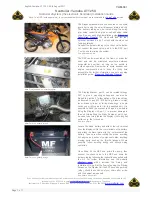
Rev. 11/6/2020
OLA-2 MANUAL
Copyright 2020 Vestil Manufacturing Corp. Page 6 of 8
b. OLA-2-36-DLX & OLA-2-42-DLX: slide
the bale along the lifting arm and seat
the bale pin into one of the pin slots in
the underside of the lifting arm.
i. Lifter tilts forward (fork tips down):
Shift bale mechanism towards the
free end of the lifting arm.
ii. Lifter tilts backwards (fork tips up):
Shift bale towards the back of the
lifting arm.
4. Minimize swinging! Make sure that the
hoist is centered above the bale, i.e. hoist
chain/rope is vertical. If the hoist
chain/rope is not vertical, the lifter will
swing as it is elevated.
5. Slowly raise the lifter. Watch the device as
it elevates. If the lifter begins to tilt
forwards or backwards, return the lifter to
the ground and adjust bale position as
described in step 3. Raise the lifter again
to determine whether it is balanced. If
balance has been achieved, proceed to
the next step. Otherwise, try again to
balance the lifter. If the lifter cannot be
balanced, use another lifting device to
handle the load.
6. Stand behind the lifter. Grasp both operator handles and gradually begin pushing the lifter in the
necessary direction. Avoid sudden starts and stops.
7. Lower the lifter onto even, level ground. Make sure that the pallet and load are stable and entirely
supported by the ground.
8. Raise the lifter just enough to carefully withdraw the forks from the pallet. Before leaving the lifter,
lower it to the ground and disconnect the hoist chain/rope from the bale.
RECORD OF SATISFACTORY CONDITION (THE “RECORD”)
Record the condition of the lifter before putting it into regular service. Thoroughly photograph the unit
from multiple angles. Include close range photos of all labeling, the forks, bale loops and pins, width
adjustment pins, height adjustment pins, and all welds. Measure the length and width of the bale
opening. Record your measurements. Write a description of the overall condition of the lifter. Collate
the photographs and writings into a single file. Mark the file appropriately to identify it. The file is a
record of the lifter in satisfactory condition. Compare the results of all inspections to this
RECORD
to
determine whether the unit is in satisfactory condition. If the lifter is not in satisfactory condition, repair it
before returning it to service. Purely cosmetic changes, like damaged paint/powdercoat, do not
constitute changes from satisfactory condition. However, touchup paint should be applied to all affected
areas as soon as cosmetic damage occurs to prevent rusting and corrosion. If left unaddressed,
rust/corrosion will degrade the condition of the lifter and could make it unsafe to use.
LOAD TESTS
After creating a
RECORD OF SATISFACTORY CONDITION
efore using the lifter for the first
time, a qualified person should conduct a load test. The test load should be 125% of the rated load, i.e.
2000lb.x1.25 = 2500lb. (1136.4kg). Elevate the lifter a few inches above the ground. After a couple
minutes, return it to the ground and unload it. Perform a
on p. 7. The (qualified) person performing the test must compose
a written report confirming the load rating of the lifter. The load rating should not be more than 80% of
the test load. The lifter must undergo load testing whenever it is repaired. Never modify the lifter without
first obtaining written approval from Vestil.
OLA-2-36/42-DLX
A
Bale pin
Bale
loop
A
B
B
Height adjustment pin
Front of
lifting arm
Fork
Operator
handle


























